Contents
Key Insights
Why Free-to-Own is Better than Previous Narratives?
- Fully utilizes the blockchain to make game assets on-chain, making it easier to price and circulate, which is the foundation of trust and the core source of revenue for the transaction royalties.
- Creators actively make the way to obtain economic benefits long-term (using royalties instead of one-time sales), which ensures consistency between their own interests and those of players/communities in the business model. This makes it easier to gain users’ trust and long-term investment in the project, forming a truly cohesive and vibrant community.
- Through the pre-release and gradual operation of NFT game assets, it ensures that there is already an energetic and expectant community before the core game project goes online, reducing the risk of a cold start for traditional Free to Play games.
Sufficient Cash and Low Valuation
- Financing: Limit Break has announced $200 million in funding and is now cash-rich with plans for long-term construction, considering that the current ecological market value is only $40 million and traditional NFT communities haven’t discovered its value yet, the price belongs to the undervalued range.
- Royalties: After four months of release, DigiDaigaku Genesis collection alone has a transaction volume of nearly 20k ETH, which leads to more than 1000 ETH in royalties as revenue.
Continuous Mechanism Innovation & Flexible and Rapid Execution Capability
- With the release of financing information and the narrative of (Free, Own). From the start, it sparked heated debate throughout the crypto community. In response to the royalty challenge, it attempted to promote the high integration of NFT and Web3 games from a technical perspective, allowing for greater imagination in new narratives.
- Seizing the BTC NFT hotspot may become the first official NFT blue chip to enter the BTC ecosystem.
Top Team, Equipped with Web2 / Web3 Experiences
- The core team is from Machine Zone, a veteran of Free to Play, specializing in deciphering whale players’ intentions. Game of War: Fire Age, a game they launched, had users spend five times the average annual amount paid by mobile game players, with some users spending millions on the game.
- The team has robust technology power and bandwidth, enabling seamless free mint experience following Super Bowl Ad. And the programmable royalty protocol is creative.
- Through the founder’s strong appeal and the high cohesion of the “cult-like community,” it has collaborated with multiple projects (Castaways, EtherOrc), ignited the communities of other games, and confirmed the user overflow of Digi community. Among the collaborative projects, Castaways is still popular and currently has 120,000+ monthly active users.
Digi Shall Fully Capture the Value of Limit Break’s Thrive
- The programmable royalty protocol to be implemented later may divide transaction royalties among existing Digi holders in the series.
- In the expected release game, there may be more value capture for the NFT design of the Digi series. In addition, Machine Zone’s games have no shortage of whale players who spend millions of dollars. For a game with tens of millions or even billions of users, 2022 Digi Genesis NFTs have an absolute rarity.
Main Risks
DigiDaigaku series NFTs mainly face two potential risks, one related to NFTs and the other to the games. Regarding NFTs, the complex ecosystem of the Digi series NFTs can easily discourage players unfamiliar with it. As for the games, there are three challenges: whether they can deliver high-quality games and achieve good user retention, whether the vast NFT system and the value capture of the project can be well connected, and whether the game products and content IP can appeal to young users’ aesthetics. For more information, please refer to “III. Business Analysis – Risks” section.
Valuation
Considering that the market value of the Digi series NFT is only about $40 million, and the valuation of the Limit Break primary market has not yet been announced, with a conservative estimate of 20% of the shares sold, it is worth $1 billion, and the financing amount alone is $200 million. With consecutive project development, sufficient cash flow and well-anticipated game design, the current market value of the DigiDaigaku series NFT has been assessed undervalued. Refer to “IV. Preliminary Valuation – Valuation” section for more details.
Project Overview
Business Scope
Limit Break is a Web3 gaming company with the game still in development, which released the DigiDaigaku NFT series in August 2022. The Digi ecosystem (hereafter referred to as “Digi”) is comprised of a series of NFTs, primarily consisting of two types: (1) Core NFTs, also known as “factory” NFTs, can continuously receive airdrops and empowerment throughout the development of the Digi ecosystem. (2) Material NFTs, usually obtained through airdrops, which users can burn through specific methods to generate core NFTs.
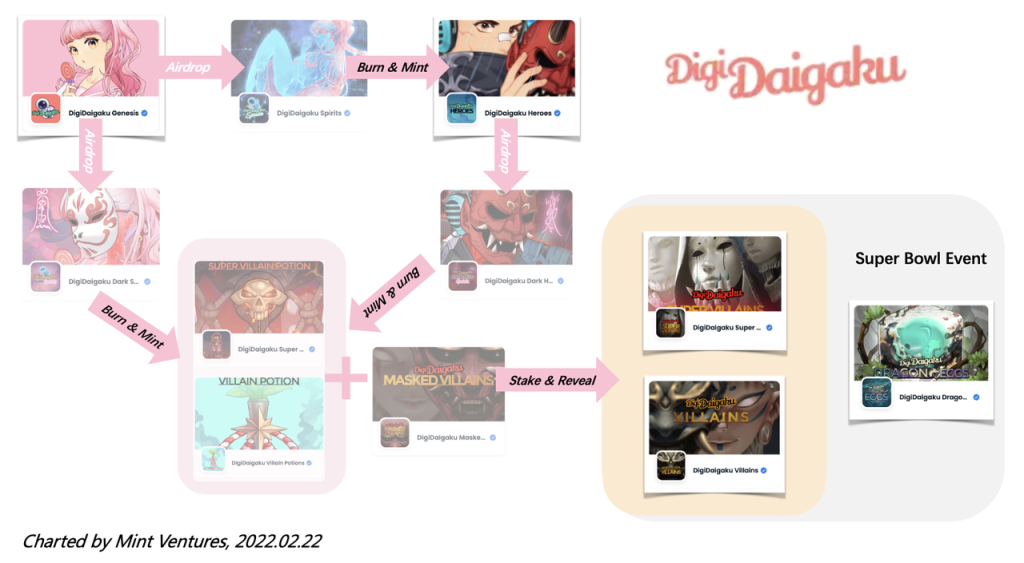
When DigiDaigaku was launched, founder Gabriel Leydon emphasized its business philosophy of Free-to-Own (abbreviated as F2O, meaning to own NFTs for free).
Gabriel Leydon further explained the meaning of F2O: first, all NFTs are obtained for free without any first-minting fee (instead, a 10% creator royalty fee is charged from transaction fees). Second, core NFTs will continue to receive new NFT airdrops throughout the development of the ecosystem.
Currently, both Limit Break and Digi ecosystems have not issued fungible tokens.
History & Roadmap
Gabriel Leydon: Pioneer of F2P Returns with F2O
Looking at the career path of Limit Break CEO Gabriel Leydon (hereinafter referred to as Gabe), we can see a narrative that is similar to Digi’s “hero’s journey”. In 1998, at the age of 19, Gabe graduated from high school and worked at an amusement park for an hourly wage of $3.25. He once described himself as “Your average loser, basically, like a faceless, nameless loser that was going nowhere in life.” One day, the amusement park tested a racing game called San Francisco Rush, Alcatraz Edition, which had a $500 weekly tournament prize. As an amusement park employee, Gabe had unlimited tokens and the game was his greatest talent. So at the age of 19, Gabe became deeply addicted to the racing game tournament, playing for over ten hours a day, to the point where he suffered a permanent injury to his thumb.
Due to his proficiency in this racing game, many people even drove from LA to San Francisco to meet Gabe, which landed him his second job as an arcade game tester at Atari. It was a relatively simple and mechanical job: play games, complain about games, and ask developers to improve them… He yearned for more challenging gameplay, as a hardcore player, wider point gaps and the satisfaction of technical domination represented his skills and status, so he kept complaining. One day, game developer Steve Richie heard his complaints and asked Gabe, “Do you know what’s the most profitable arcade game?” Gabe discovered a reality that shattered his illusion: the most profitable racing game was Cruis’n in USA, which even if the pedals were broken or the steering wheel malfunctioned, the player would not know, the car would always move on the preset track, and the player would always finish third.
This 19-year-old moment laid the foundation for Gabe’s entire career understanding of games: games are not just games themselves, they are a business, and game developers are not only artists but also businessmen. He said in Invest Like the Best:
So when you interview game designers, they all know how to add pets. They all know how to make levels or whatever. They all know how to play Pokemon. They’ve all been playing Dungeons and Dragons for thousands of years. They know how to do this stuff. But they don’t know how to do the other side at all and they actually hate it. So that’s why I ask the question because if you hate the business side of it, you’re not going to be good at it.
Gabe spent 7 years in the arcade game industry, first at Atari, then at Tsunami Visual and Global VR, where he designed the first arcade game for the US Army. After leaving the arcade industry, Gabe went to Y Combinator with his friend Halbert Nakagawa. This well-known Silicon Valley incubator has produced a series of renowned projects, such as Airbnb, Coinbase, Doordash, Dropbox, and the gaming dating platform Addmired, the predecessor of Machine Zone. It was 2008, two years after Facebook attempted to create an ecosystem for developers based on their platform, with social gaming company Zynga being one of the most representative participants. From online poker to farm games, Zynga’s Farmville had 80 million users at its peak, which was unimaginable when only 30% of households worldwide had a computer and the iPhone 1 had only been released for six months. Due to Zynga’s success, Addmired chose to develop social games on Facebook’s competitor, Myspace, but the results were dismal. Zynga chose to finance more money and aggressively advertise on Facebook for greater exposure, becoming the platform’s largest advertiser, while Gabe’s small team of three was struggling with the waning social platform, Myspace, with their early-stage funding. So they chose to take a different approach: since Zynga had not yet entered the mobile market, why not create games for the iPhone? From 2009 to 2012, Addmired created a total of 13 games, including four on iOS: Original Gangstaz, iMob, iMob2, and Global War Riot. Although they did not cause a huge stir, they were still a relatively innovative attempt.
The Victory of Game of War: Fire Age’s Innovative Mechanisms
In October 2012, Machine Zone released the SLG (war strategy simulation) game Game of War: Fire Age. Gabe claimed to have bet all of the Series A funding on this project and formed an 80-person team that spent 18 months fully devoted to its development. In 2013, the game began to be released on the US market and became one of the best-selling apps in 2014 and 2015. Before explaining its groundbreaking innovations, it is necessary to provide some context for a better understanding of the era:
- In 2012, iPhone 5 was released, and the number of apps in the App Store was still in its early stages, with commercialization in the exploratory phase. From 2010 to 2013, Apple’s revenue sharing with developers was still in the ramp up period before the explosion.
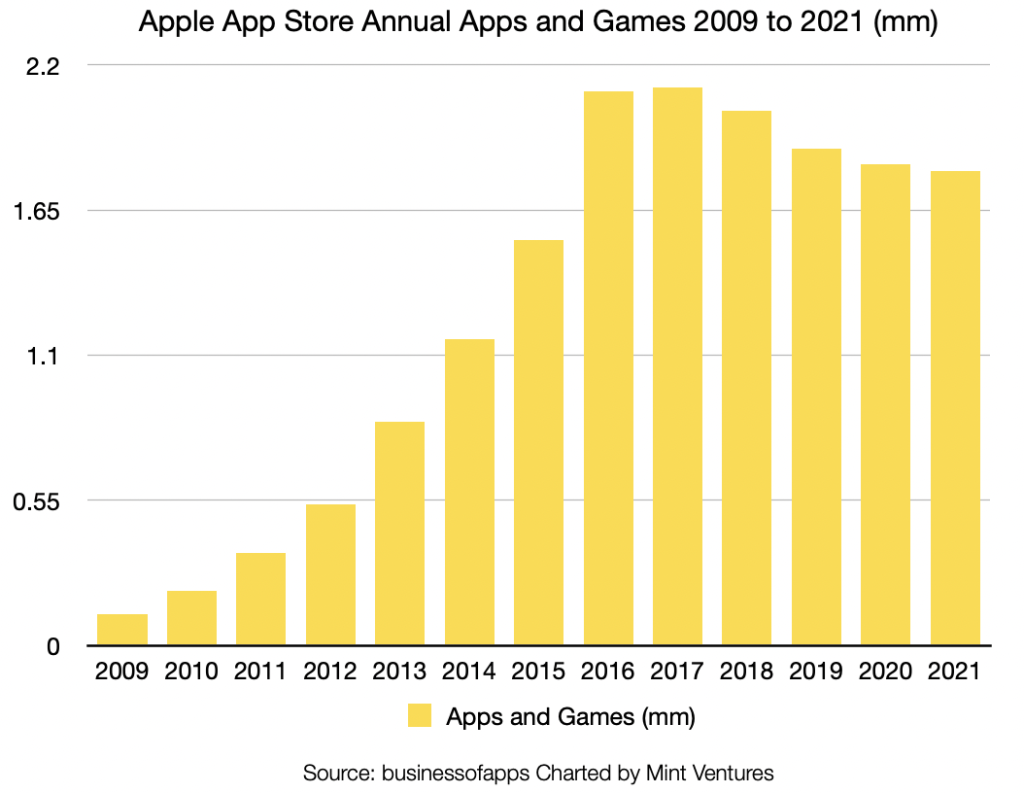
- During the development of Game of War at Machine Zone, the mobile gaming industry was still in the era of casual games such as Angry Birds. While there were many high-quality games, most were constrained by the limitations of “porting” from console/PC games and suffered from revenue loss due to piracy and cracked versions. In December 2011, gaming media outlet Gamesbrief described several games that were likely to generate over $20 million in revenue in 2011 with considerable enthusiasm. Compared to the current multi-billion dollar revenue of top mobile games, the mobile gaming industry at the time was indeed in its early stages.
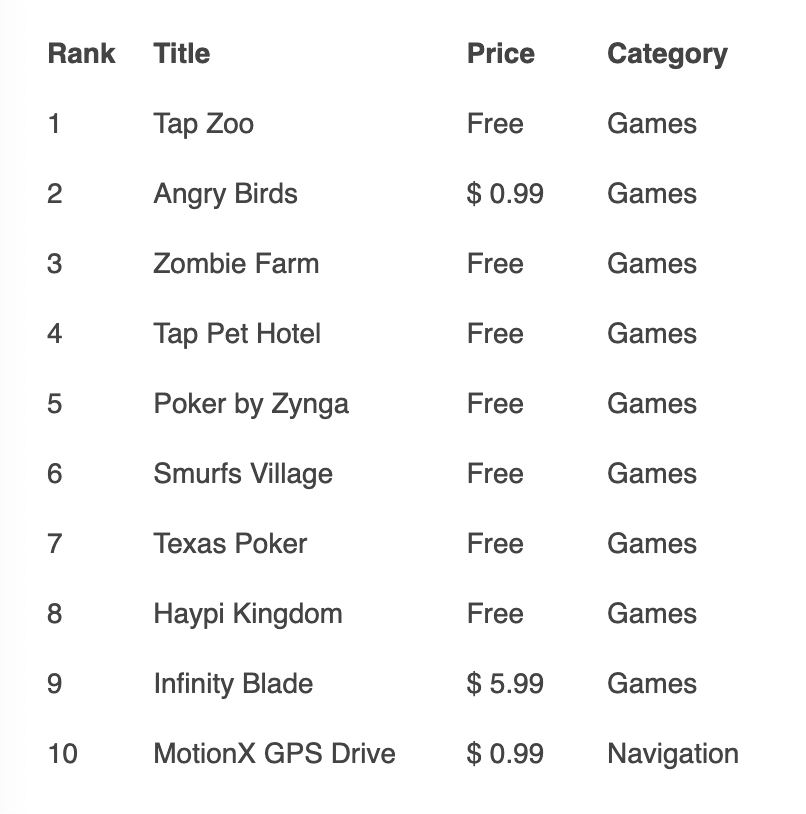
During a time when mobile gaming revenues had not yet reached their full potential, Machine Zone launched Game of War: Fire Age, which had three innovative features:
- Massive Multiplayer Online (MMO) on a global scale: Wars in the game could happen at any time, and players needed to defend their kingdoms or battle against other countries at a moment’s notice. The boundary between virtual and reality was blurred, and players might receive a phone call from their guild friends while walking on the street, requesting help in reclaiming their hero.
- Ingenious monetization design: Game of War was one of the earliest mobile games to introduce the Free to Play (F2P) game model, which combines free gameplay with in-game purchases. Now, paying for acceleration, buying skins, or acquiring top-tier equipment at a high price is conventional in mobile games, it all boils down to their pioneering efforts. Also, they managed to push players’ consumption desires to the extreme by precisely understanding user intention. They are made for “whales”, players who make large purchases in the game, and the whales have never let them down. In 2015, the average spending per Game of War player was as high as $550, while the annual average spending per mobile game player was only $86.50.
- Built-in real-time chat system and automatic translation: The in-game chat room allows 3.2 million users to chat online simultaneously, with a message delay of less than 200 milliseconds. Gabe states at the 2013 Game Developers Conference (GDC) that even armies could have a demand for such a chat system. Furthermore, since the game has a global user base, they put a lot of effort into localization: all chat messages in the world channel are automatically translated into the user’s native language, and messages will be pushed to users in their native language even if they are offline. Players can enjoy a seamless experience fighting and celebrating with users from all over the world.
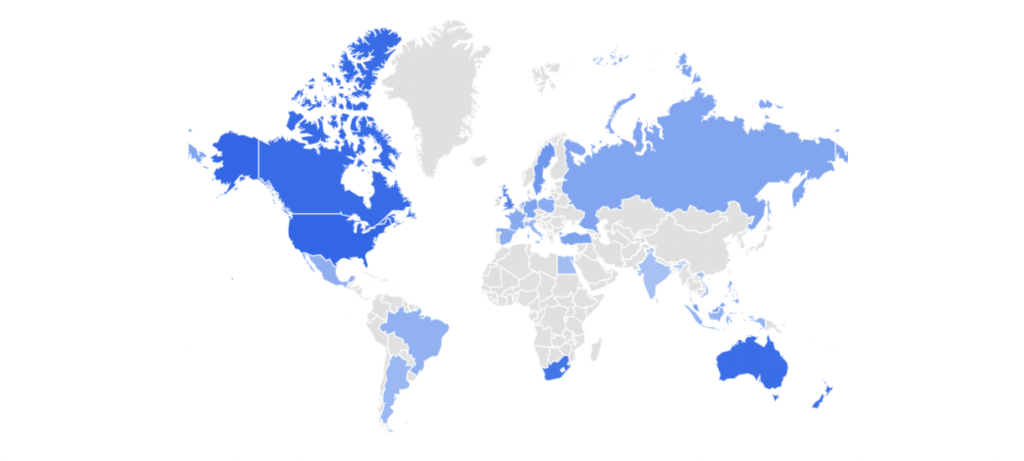
For the early mobile gaming industry, this was undoubtedly a smart innovation. Despite the game’s relatively rough graphics, and its depth and pacing, which may not satisfy modern standards, this did not prevent Game of War from becoming Machine Zone’s cash cow. This time, they learned from the lesson of Addmired being bombarded by Zynga’s advertising and chose to invest heavily in advertising:
- In 2014, the marketing expenses for Game of War: Fire Age amounted to 40 million U.S. dollars (just three years prior, in 2011, when game media mentioned “annual revenue of over 20 million U.S. dollars” for these mobile games, it was still a surprising tone).
- In 2014, Game of War: Fire Age aired an ad during the Super Bowl, bringing strong user growth to the game.
- If you search for Game of War: Fire Age on YouTube, you will see the number of views of Machine Zone ads, with the top three being viewed 160 million times, 150 million times, and 87.69 million times, respectively. This is not due to organic user views, but rather the result of their advertising efforts.

Industry insiders interpreted this as: when you realize that for every dollar you invest, you can generate more than a dollar in revenue, why wouldn’t you do it? At its peak, (except in China) , males all over the world would see at least two ads for Machine Zone’s games every day. In 2014, Machine Zone completed a $250 million investment from JP Morgan. According to Fortune magazine, its valuation was at least $3 billion, which is a glimpse of the glory of Game of War at that time.
Mobile Strike & Final Fantasy XV: Reproducing the Original Game
In 2015, Machine Zone released Mobile Strike, a game with mechanics very similar to Game of War: Fire Age. The difference was that Game of War was set in the medieval era, while Mobile Strike was set in modern warfare, making it more appealing to younger players.

In 2016, Machine Zone rebranded as MZ and completed a new round of financing valued at $5 billion, emphasizing the company’s advantages in game infrastructure technologies such as social and data analytics. In November of the same year, Machine Zone partnered with Square Enix to launch “Final Fantasy XV: A New Empire,” a spin-off mobile game of the Final Fantasy XV series. Looking at the game interface, it is almost a duplicate of Game of War and Mobile Strike, except that it uses Final Fantasy series skins and resource settings, and the gameplay is extremely similar to the previous series.
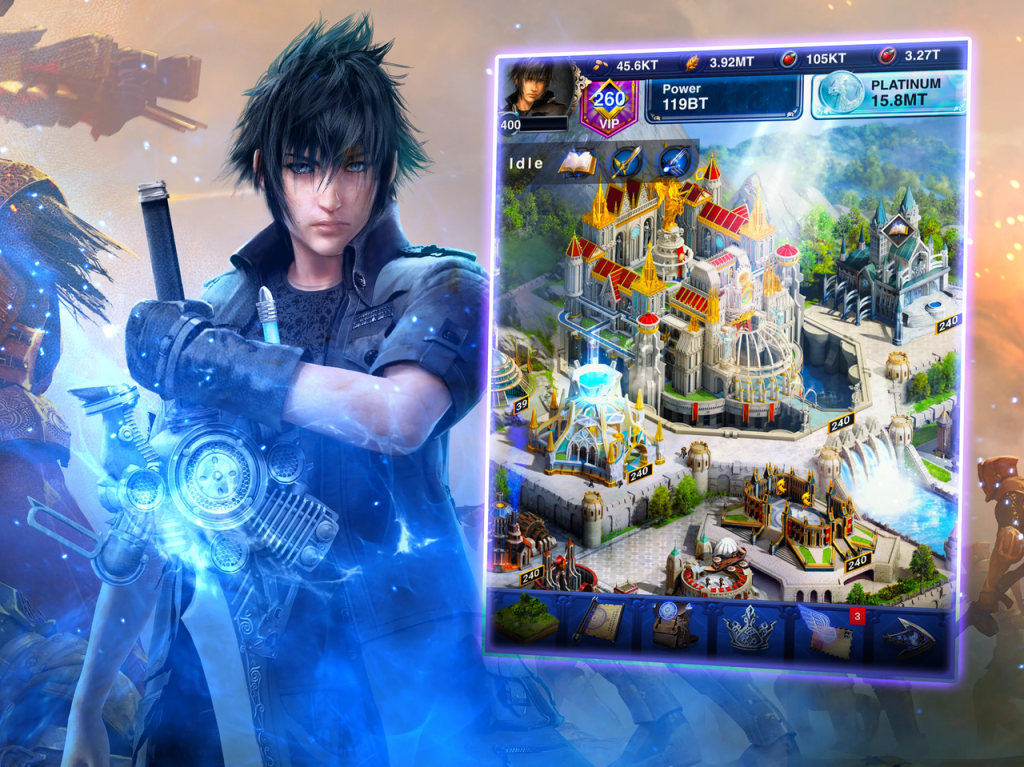
Meanwhile, the gaming market was seeing a flourishing of innovation. In 2015, Tencent released “Honor of Kings”; in 2016, there were innovative games like “Pokemon Go” which utilized AR + LBS technology, as well as Supercell’s “Clash Royale” which continues to be popular today. With deeper, more innovative gameplay and social features, consumers’ tastes have evolved, and mere copycats with no new tricks up their sleeves are unlikely to sustain long-term success. While “Final Fantasy XV: A New Empire” still generated a lot of buzzes, its popularity quickly waned, and its actual download figures on Google Play were much lower than the previous two games.

The revenue of these three games is also showing a downward trend.
From Stealth Free Mint to a Pre-Blue Chip: A Brief History of DigiDaigaku
| Time | Event |
|---|---|
| 2021.06.08 | Gabe was a guest on the well-known business podcast Invest Like the Best, where he shared his understanding of designing digital economic systems. (At this time, he may have already started fundraising.) |
| 2022.07.27 | Alok Vasudev, the founder of Standard Crypto and an investor in Limit Break (the parent company of DigiDaigaku), mentioned on Invest Like the Best that he had invested in Gabe’s company, which was also retweeted by Gabe. This was the first public exposure of Limit Break, although most people knew nothing about it at the time. |
| 2022.08.04 | Gabe officially announced on Twitter the founding of his new company, Limit Break, with his good friend and Machine Zone co-founder Halbert Nakagawa. He listed the names of the investors and ended the tweet with the message “Although there is no more content to share now, we will have a little surprise for everyone soon.” Matt Huang, the founder of Paradigm, retweeted and recommended Gabe’s podcast from 2021, saying that it is worth a listen to understand the philosophy behind the company. |
| 2022.08.09 | Gabe announced on Twitter “freemint tomorrow evening” (now deleted). |
| 2022.08.10 | At 2-3 am Beijing time, DigiDaigaku’s freemint began, and despite no community partnerships or promotions, 2022 Digis were minted in just 17 minutes. After a few sales below 1E at the beginning, the floor price stabilized at around 3E. This freemint was also thoughtfully designed in its details, allowing only web front-end minting, effectively avoiding the situation where bots have a large number of NFTs. |
| 2022.08.11-2022.08.28 | Gabe hosted a Twitter Space with investors, discussing Digi’s philosophy and engaging with well-known gaming guild YGG and VC Delphi Digital. Alongside sharing memes and jokes, they also held a vote to determine Digi’s next plan, which was an airdrop. |
| 2022.08.29 | Limit Break announced a funding amount of $200 million and launched the “Free to Own” narrative. CZ retweeted and commented, “VCs are creating fictitious narratives again.” That night, the floor price of DigiDaigaku Genesis reached a peak of 16.8 ETH, pushing the hype to a climax.Gabe announced on Twitter that he would collaborate with his past investments, such as YGG and Castaways_gg, to build the Free to Own universe. |
| 2022.09.03 | Airdrop DigiDaigaku Spirits to DigiDaigaku Genesis holders, with a floor price of 4.3 ETH at launch. |
| 2022.09.04 | The DigiDaigaku Heroes event begins, allowing players to burn their DigiDaigaku Spirits to obtain heroes with different bloodlines. The bloodline of a hero is determined by whether the wallet that burned the Spirit also holds a corresponding DigiDaigaku Genesis and if the numbers match: – If the holder owns a DigiDaigaku Genesis with the same serial number as the burned Spirit, the hero’s bloodline is Royal. – If the holder owns a DigiDaigaku Genesis with a different serial number than the burned Spirit, the hero’s bloodline is Warrior. – If the holder only owns a Spirit, the hero’s bloodline is Rogue. In addition, there are five Mythic (1/1) NFTs among the 2022 DigiDaigaku Genesis, and the hero created by combining them will have the Mythic bloodline. Because the rare bloodlines have a certain premium, users may be willing to give up a Royal bloodline in favor of combining Spirits with different serial number Genesis to obtain a Mythic Warrior hero. In terms of the ecosystem, Royal > Warrior > Rogue, but in terms of actual floor price, users prefer the scarce Mythic Warrior hero, which is currently trading at roughly twice the floor price of other bloodlines. |
| 2022.10.02 | DigiDaigaku Genesis holders will receive an airdrop of Castaways Adventure Key, and holders will receive a little girl character in Castaways that looks similar to their Genesis, and participate in the leaderboard competition. Top performers on the leaderboard will receive custom prizes from Castaways, as well as island rewards (valued at around 4E at the time). The opening price of Castaways Adventure Key is 0.9 E. |
| 2022.10 – 2022.11 | DigiDaigaku is hosting a pumpkin carving contest, where 2 videos of pumpkin carvings will be selected to be featured in the 2023 Super Bowl commercial. Hundreds of people enthusiastically participated in the pumpkin carving, and in the end, 2 people were chosen for the honor. |
| 2022.11.01 | Dark Spirits will be airdropped to DigiDaigaku Genesis and DigiDaigaku Hero holders, with the following distribution: – Each DigiDaigaku Genesis holder will receive 2 Dark Spirits. – Each Royal and (Mythic) Warrior Hero holder will receive 2 Dark Hero Spirits. – Each Rogue Hero holder will receive 1 Dark Hero Spirit. |
| 2022.11.17 | Airdrop EtherOrcs Adventure Key to DigiDaigaku Genesis holders, similar to the Castaways Adventure Key, where holders will receive a special character from EtherOrcs and compete for leaderboard rewards. |
| 2022.12.02 | The Dark Spirits and Dark Hero Spirits collections will introduce the mechanism of burning to generate potions: – Burning a Dark Spirit or Dark Hero Spirit will only result in a Villain Potion. – Burning a Dark Spirits and Dark Hero Spirits together will result in a Super Villain Potion. These potions will empower the upcoming Villain series, enabling Villains in the game to possess weapons and attribute enhancements to different levels. |
| 2023.01.27 | DigiDaigaku’s Masked Villain is now available for sale, with a total of 10,000 units in a Free Mint format. Genesis and Hero owners can claim their NFT directly on the official website, while the remaining 6,000 Masked Villains will be distributed through a lottery on FreeNFT.xyz at a floor price of 0.45 ETH. FreeNFT is also a project that Gabe has invested in and will serve as a launchpad for the Free to Own ecosystem. In addition to DigiDaigaku’s previous lottery on the platform, Castaways_gg and Dimensionals will also collaborate with FreeNFT. The platform has become a top choice for high-quality Freemint project owners, with its main advantage being its powerful anti-bot capabilities, resulting in a higher proportion of genuine users and greater influence. FreeNFT can also drive high-quality community growth. During the promotion of the second-generation island Freemint, the founder of Castaways_gg saw a slow increase in Twitter followers during the first island’s sale, but saw a surge of 269,000 new followers in one week during the promotion of the second island on FreeNFT, bringing the total number of followers to 336,000. |
| 2023.02.13 | DigiDaigaku made a splash at the Super Bowl with their advertisement and launched a Free Mint event for the DigiDaigaku Dragon. It’s reported that the 30-second ad cost $650M and was seen by millions of viewers. |
| 2023.02.16 | Announced that DigiDaigaku Genesis will be released on BTC, and holders of DigiDaigaku Genesis will receive free BTC DigiDaigaku Genesis. |



